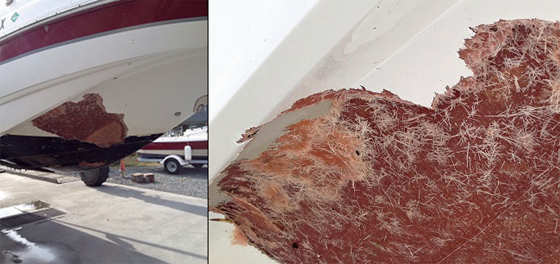HULL DELAMINATION
01 November 2013 00:00 Filed in: Workmanship
The interesting topic emerged on Chaparral Boats user forum … here

EXCUSES ASIDE …
… there is one primary reason this has happened ... poor workmanship ... period.
With plastic hulls (GRP ... polyester/plastic is a key word in this acronym), the quality of fiberglass layup makes or breaks the hull. The failure might start with deficient layer of gelcoat and blisters on the outside, or with leaky boat (as most Chaps are) inside the boat where protective gelcoat is punctured by unsealed holes, or where GRP exposed to water is not protected by gelcoat at all (like most Chaps are in the midship bilge and bow bilge area).
The delamination is a result of water getting in contact with GRP plus poor workmanship resulting in voids between layers, and/or poor adhesion between layers, and/or capillary transport of water along exposed or not saturated fibers.
You can clearly see in the pictures the area which was weak and the layer of GRP (not just gelcoat) was torn away leaving the "dry" fibers ... fiberglass layer poorly saturated with resin. You can also see the area where the external layer of GRP was separated cleanly (no adhesion) from the rest of the hull ... somebody took a lunch break, or the resin cured too fast.
It's not the user fault ... period.
BTW, keep your plastic boats as dry as possible ... sounds weird, doesn't it? Use a quality barrier coat on the outside. Chase any and all leaks inside the boat till you eradicate them.
For the reference and information … The Real Story of Osmosis Blistering
Marine surveyor view and more … Are They Fiberglass Boats Anymore?

EXCUSES ASIDE …
… there is one primary reason this has happened ... poor workmanship ... period.
With plastic hulls (GRP ... polyester/plastic is a key word in this acronym), the quality of fiberglass layup makes or breaks the hull. The failure might start with deficient layer of gelcoat and blisters on the outside, or with leaky boat (as most Chaps are) inside the boat where protective gelcoat is punctured by unsealed holes, or where GRP exposed to water is not protected by gelcoat at all (like most Chaps are in the midship bilge and bow bilge area).
The delamination is a result of water getting in contact with GRP plus poor workmanship resulting in voids between layers, and/or poor adhesion between layers, and/or capillary transport of water along exposed or not saturated fibers.
You can clearly see in the pictures the area which was weak and the layer of GRP (not just gelcoat) was torn away leaving the "dry" fibers ... fiberglass layer poorly saturated with resin. You can also see the area where the external layer of GRP was separated cleanly (no adhesion) from the rest of the hull ... somebody took a lunch break, or the resin cured too fast.
It's not the user fault ... period.
BTW, keep your plastic boats as dry as possible ... sounds weird, doesn't it? Use a quality barrier coat on the outside. Chase any and all leaks inside the boat till you eradicate them.
For the reference and information … The Real Story of Osmosis Blistering
Marine surveyor view and more … Are They Fiberglass Boats Anymore?


